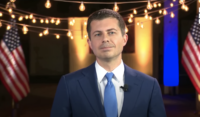After easily winning Senate confirmation, new U.S. Transportation Secretary Pete Buttigieg is expected to take on a prominent role in President Joe Biden's expected push for a massive economic recovery plan, including a sizable increase in federal infrastructure funding.
The critical hurdle now, as has been true over and over in the past, will be figuring out how to pay for the program—and convincing Congress to sign on to a revenue-raising plan.
Industry officials say Buttigieg's skills, popularity as a former presidential candidate and transportation knowledge gained as mayor of South Bend, Ind., make him a solid choice as point person for the administration's drive for a recovery/infrastructure program.
Steve Hall, American Council of Engineering Companies senior vice president for advocacy, says, "He's a very articulate leader, understands infrastructure at a very granular level [and] as mayor, understands what it really means in terms of local economies."
Bipartisan Vote
Buttigieg, a Democratic presidential hopeful last year, won Senate confirmation on Feb. 2 on a strong 86-13 vote. That vote made him the first openly gay Cabinet nominee to gain Senate confirmation.
All 13 “no” votes were Republicans. But Buttigieg did receive votes from 36 GOP senators—more than 70% of their contingent. That may bode well for administration legislative initiatives in the transportation sector. “It’s an encouraging start,” says Hall.
Buttigieg will have to hit the ground racing. Biden has said he plans later in February to unveil his Build Back Better recovery plan, including what he has called “historic investments in infrastructure.”
Highway-transit Deadline
The largest component in the recovery plan's infrastructure sections is almost certain to be surface transportation—highways and transit. Increased spending will require additional revenue.
As Congress and the administration eye the prospect of the Building Back Better proposal, they face a ticking clock for surface transportation. The current authorization measure expires on Sept. 30.
There's a further complication. As Sean O’Neill, Portland Cement Association (PCA) senior vice president for government affairs, notes, the Highway Trust Fund—a prime source of highway and transit funding—“is facing an all-too-familiar dilemma, which is insolvency.”
Michael Johnson, the National Stone, Sand & Gravel Association’s president and chief executive officer, sees a two-part challenge ahead. Johnson said in a statement that highways and bridges are “the economic circulatory system for our nation.” He added, “Therefore it is key to have a long-term Highway Trust fund plan in future infrastructure proposals and solve the [near-term] financial issues of the ... trust fund.”
Search for Revenue
O’Neill says, “How we end up paying for [the next surface transportation] bill is, I think, lingering over all of us— but in particular it’s lingering over the administration and the Congress."
O'Neill adds that, based on Buttigieg's comments at his Jan. 21 confirmation hearing, "We're encouraged by his acknowledgement of the need to find revenue, and I think, the willingness to work with Congress to do that." [View ENR story on confirmation hearing here.]
DOT Team
Buttigieg lacks experience on Capitol Hill or at U.S. DOT. But Ray LaHood, U.S. Transportation Secretary for the opening years of the Obama administration, said, “The team that [Buttigieg] is assembling to serve with him at the department brings deep knowledge of both policy and process that will pay dividends in crafting a visionary and robust infrastructure plan.”
For example, Biden's nominee for DOT deputy secretary is Polly Trottenberg, who formerly had been Commissioner of the New York City DOT for seven years. Earlier, Trottenberg was the U.S. DOT Under Secretary for Policy in the Obama administration. Before that, she was an aide to Sens. Chuck Schumer (D-N.Y.)—now the incoming majority leader—former Sen. Barbara Boxer (D-Calif.), and the late Sen Daniel Patrick Moynihan (D-N.Y.).
The administration has named many others to sub-Cabinet DOT posts who have experience at the department or state and regional agencies, private industry and on Capitol Hill.
Media-savvy
Buttigieg may be able to bring infrastructure to a wider audience. For example, the night before his Senate hearing, Buttigieg appeared on NBC's “Late Show Starring Jimmy Fallon,” not the usual venue for DOT nominees. He also has 3.3 million Twitter followers.
Jeff Urbanchuk, ACEC vice president for communications and marketing says, “There are few Cabinet members as telegenic and savvy about the media as Buttigieg is.” He says, “If you're trying to sell Build Back Better to an outside-D.C. audience, he's a great person to have.”
But PCA's O'Neill says that before the administration tackles the recovery/infrastructure proposal, it is focusing on passing a coronavirus relief package. Biden has proposed a $1.9-trillion plan. A group of 10 GOP Senators have released a $618-billion counterproposal.
Biden invited the 10 lawmakers to the White House for a Feb. 1 meeting. But Democratic leaders, whose party narrowly controls the House and Senate, have moved toward a possible legislative vehicle for the $1.9-trillion plan that would require simple majorities in each chamber.
Neither the Biden nor the Republican senators' proposals has much, if any, direct construction funding.
O'Neill says that whatever the final COVID-19 relief bill's shape is “will determine the next steps.” He adds, “And that will be what is likely an infrastructure and climate package.”





Post a comment to this article
Report Abusive Comment